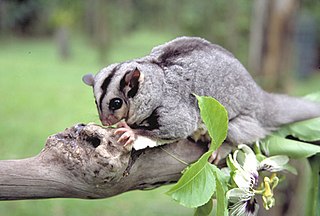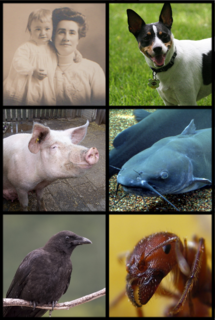
Mammals are a group of vertebrate animals constituting the class Mammalia, characterized by the presence of mammary glands which in females produce milk for feeding (nursing) their young, a neocortex, fur or hair, and three middle ear bones. These characteristics distinguish them from reptiles from which they diverged in the Carboniferous, over 300 million years ago. Around 6,400 extant species of mammals have been described divided into 29 orders. The largest orders, in terms of number of species, are the rodents, bats, and Eulipotyphla. The next three are the Primates, the Artiodactyla, and the Carnivora.
Zoology is the branch of biology that studies the animal kingdom, including the structure, embryology, evolution, classification, habits, and distribution of all animals, both living and extinct, and how they interact with their ecosystems. The term is derived from Ancient Greek ζῷον, zōion ('animal'), and λόγος, logos.

Eucynodontia is a clade of cynodont therapsids including mammals and most non-mammalian cynodonts. The oldest eucynodonts are known from the Early Triassic and possibly Late Permian. Eucynodontia includes two major subgroups, Cynognathia and Probainognathia.

In zoology, mammalogy is the study of mammals – a class of vertebrates with characteristics such as homeothermic metabolism, fur, four-chambered hearts, and complex nervous systems. Mammalogy has also been known as "mastology," "theriology," and "therology." The archive of number of mammals on earth is constantly growing, but is currently set at 6,495 different mammal species including recently extinct. There are 5,416 living mammals identified on earth and roughly 1,251 have been newly discovered since 2006. The major branches of mammalogy include natural history, taxonomy and systematics, anatomy and physiology, ethology, ecology, and management and control. The approximate salary of a mammalogist varies from $20,000 to $60,000 a year, depending on their experience. Mammalogists are typically involved in activities such as conducting research, managing personnel, and writing proposals.

Zoogeography is the branch of the science of biogeography that is concerned with geographic distribution of animal species.

George Evelyn Hutchinson was a British ecologist sometimes described as the "father of modern ecology." He contributed for more than sixty years to the fields of limnology, systems ecology, radiation ecology, entomology, genetics, biogeochemistry, a mathematical theory of population growth, art history, philosophy, religion, and anthropology. He worked on the passage of phosphorus through lakes, the chemistry and biology of lakes, the theory of interspecific competition, and on insect taxonomy and genetics, zoo-geography and African water bugs. He is known as one of the first to combine ecology with mathematics. He became an international expert on lakes and wrote the four-volume Treatise on Limnology in 1957.

The mahogany glider is an endangered gliding possum native to a small region of coastal Queensland in Australia.
CSIRO Publishing is an Australian-based science and technology publisher. It publishes books, journals and magazines across a range of scientific disciplines, including agriculture, chemistry, plant and animal sciences, natural history and environmental management. It also produces interactive learning modules for primary school students and provides writing workshops for researchers.

Evolutionary physiology is the study of the biological evolution of physiological structures and processes; that is, the manner in which the functional characteristics of individuals in a population of organisms have responded to natural selection across multiple generations during the history of the population. It is a sub-discipline of both physiology and evolutionary biology. Practitioners in the field come from a variety of backgrounds, including physiology, evolutionary biology, ecology, and genetics.

Ecology Letters is a monthly peer-reviewed scientific journal published by Wiley and the French National Centre for Scientific Research. Peter H. Thrall is the current editor-in-chief, taking over from Tim Coulson. The journal covers research on all aspects of ecology.

Austral Ecology: A Journal of Ecology in the Southern Hemisphere is a peer-reviewed scientific journal covering research related to the ecology of land, marine, and freshwater systems in the Southern Hemisphere. It is published by Wiley and is the official journal of the Ecological Society of Australia. The journal addresses the commonality between ecosystems in Australia and many parts of southern Africa, South America, New Zealand, and Oceania. For example, many species in the unique biotas of these regions share common Gondwana ancestors. The journal was established in 1976 as Australian Journal of Ecology, obtaining its current name in 2000. As of 2017, the editor-in-chief is Nigel Andrew.
Timothy Hugh Clutton-Brock is a British zoologist known for his comparative studies of the behavioural ecology of mammals, particularly red deer and meerkats.
Graeme James Caughley was a New Zealand population ecologist, conservation biologist, and researcher. He combined empirical research with mathematical models, and supported the declining population paradigm.
Theodore Garland Jr. is a biologist specializing in evolutionary physiology at the University of California, Riverside.

An omnivore is an animal that has the ability to eat and survive on both plant and animal matter. Obtaining energy and nutrients from plant and animal matter, omnivores digest carbohydrates, protein, fat, and fiber, and metabolize the nutrients and energy of the sources absorbed. Often, they have the ability to incorporate food sources such as algae, fungi, and bacteria into their diet.

The American Journal of Primatology is a monthly peer-reviewed scientific journal and the official journal of the American Society of Primatologists. It was established in 1981 and covers all areas of primatology, including the behavioral ecology, conservation biology, evolutionary biology, life history, demography, paleontology, physiology, endocrinology, genetics, molecular genetics, and psychobiology of non-human primates. Besides its regular issues, the journal publishes a yearly supplementary issue detailing the program of the society's annual meetings. The editor-in-chief is Karen Bales. The types of papers published are: original research papers, review articles, book reviews, commentaries, and plenary addresses.
Australian Mammalogy is a major peer-reviewed scientific journal published by CSIRO Publishing on behalf of the Australian Mammal Society covering research on the biology of mammals that are native or introduced to Australasia. Subject areas include, but are not limited to: anatomy, behaviour, developmental biology, ecology, evolution, genetics, molecular biology, parasites and diseases of mammals, physiology, reproductive biology, systematics and taxonomy.

The Mammal Research Institute of the Polish Academy of Sciences (MRI) is a research institution located in the heart of Europe’s best preserved lowland forest, Białowieża Primeval Forest in Poland. The mission of the Institute is to acquire, advance, and disseminate knowledge of mammalian biology. The Institute pursues its mission by conducting research on all aspects of mammalian biology, publishing in renowned scientific journals, developing international scientific co-operation, providing academic training.

Eutheriodontia is a clade of therapsids which appear during the Middle Permian and which includes therocephalians and cynodonts, this latter group including mammals and related forms.

Restoration Evology is a bimonthly peer-reviewed scientific journal covering research on restoration ecology. It was established in 1993 and is published by Wiley-Blackwell on behalf of the Society for Ecological Restoration. The editor-in-chief is Stephen Murphy.














